Ruch Chorzów are currently sat in the relegation zone in the Ekstraklasa, following a poor start to the league campaign. New manager Janusz Niedźwiedź has just been given the job and will look to rescue the side which has only achieved one win all season.
Whilst there is cause for concern, a positive has been Ruch Chorzów’s ability to be deadly from set-pieces. 5 of the 22 league goals have come from corner kicks, and we will delve into why the new coach should stick with the current set play routines they have assembled this season.
In this tactical analysis, we will look into the tactics behind Ruch Chorzów’s offensive set-pieces, with an in-depth analysis of the corner routine to pack the six-yard box. This set-piece analysis will also look into the benefits that come from this routine, largely focused on winning second balls, and some advice that can be used to increase output in the future.
Starting positions on the goal line
Ruch Chorzów’s primary setup involves five attackers positioned within the width of both goalposts, usually with every attacker on either goal side of their markers or in their blind spot. From these positions, attackers can make the initial step towards the desired zone without defenders being able to see that first step, giving them the slight separation required from which they can build up momentum to then create space between themself and their marker.
As seen in the image below;
- One player attacks the space at the near side of the six-yard box
- One player pins the goalkeeper to the goal line
- One player roams around centrally in the six-yard box, picking up loose balls
- Two players at the back post attempt to attack flick-ons or rebounds

This routine is dependent on the quality of both the run and flick-on made by the player attacking the near side of the six-yard box. The run must be timed just right so that the attacker can arrive in the space to flick it on either towards the goal or across it, for other teammates to attack the ball. If the run is too early, the defender will be able to track the run and protect the space, while arriving for the ball too late would result in no one being present to make contact with the ball.
The image shows the attacker coming from the defender’s blind side, which is Ruch’s take on creating separation from their markers. Some teams attempt to use screens to aid separation, while a more common approach is to arrive from a defender’s shadow. Either of these methods has proven to be an effective way of attacking the ball unopposed. However, this method, arriving from the blindside, usually gives attackers a lesser amount of space. Nothing is physically blocking the marker’s path, so a well-timed scan over the shoulder could be enough to neutralize the advantages of this starting position. Without a physical block, the attackers only have a yard or two of space between their markers, meaning that there is usually only a one or two-second window in which the attacker has to attack the ball before their marker recovers the ground lost and attempts to challenge for the aerial duel.
The headed flick on toward the far side of the goal must then be weighted perfectly, not too low to be cleared by a defender, and not too high, so it misses everyone at the back post. The quality of the flick-on is crucial and depends on the ability of the player performing it; however, increasing the amount of space the attacker has can aid the quality of the flick-on. If an attacker is having to rush towards the space whilst battling a defender and flicking the ball, it may result in inconsistent results. If Ruch Chorzów can alter the landscape and create situations where the attacker can arrive in space, slow down, and attempt the flick-on with no opposition challenge, the accuracy and consistency of these flick-ons would increase, creating more clear-cut chances.
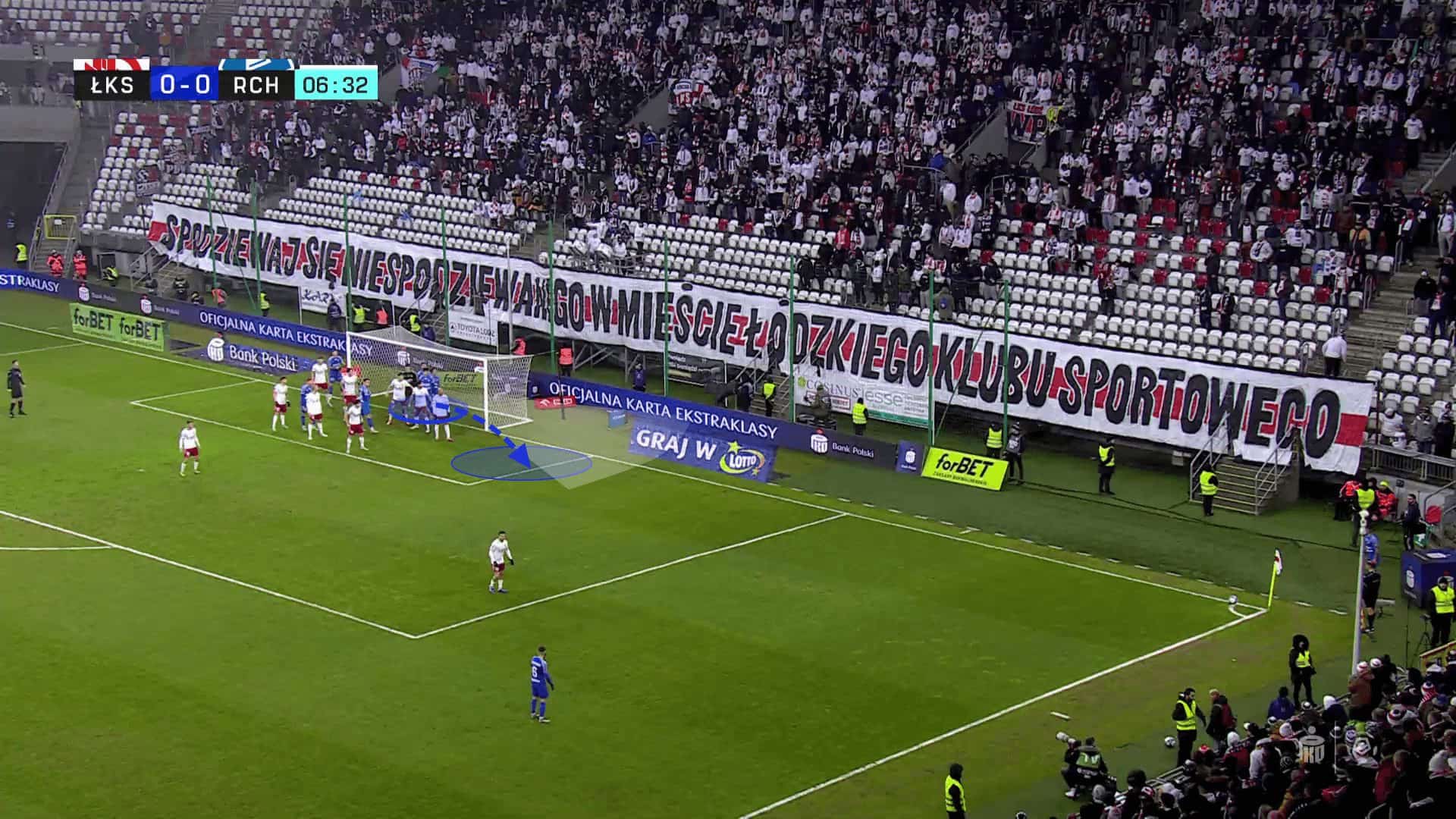
At the back post, some clever movements are used to ensure the player receiving the flick-on has no distractions or any problems attacking the ball. This involves the use of a fairly straightforward rotation, illustrated in the image below. As the attacker occupying the space at the back post has attracted a marker, making that zone less favourable to attack, his role is to create space by moving away from the back post and dragging his marker away with him.
With the space now available to attack, the deeper-positioned player drifts into the space after the corner is taken. The timing is essential to note as well. Once the kick is taken, the markers all need to focus on the ball to judge the flight so that they are ready to clear it should it go their way. During this time, the deeper attack can ghost towards the back post without his marker tracking him. The last time the marker looked over his shoulder, the back post was occupied by another defender, so there wasn’t any imminent danger. In the two seconds following, the entire picture behind his back changes, and he is entirely unaware.
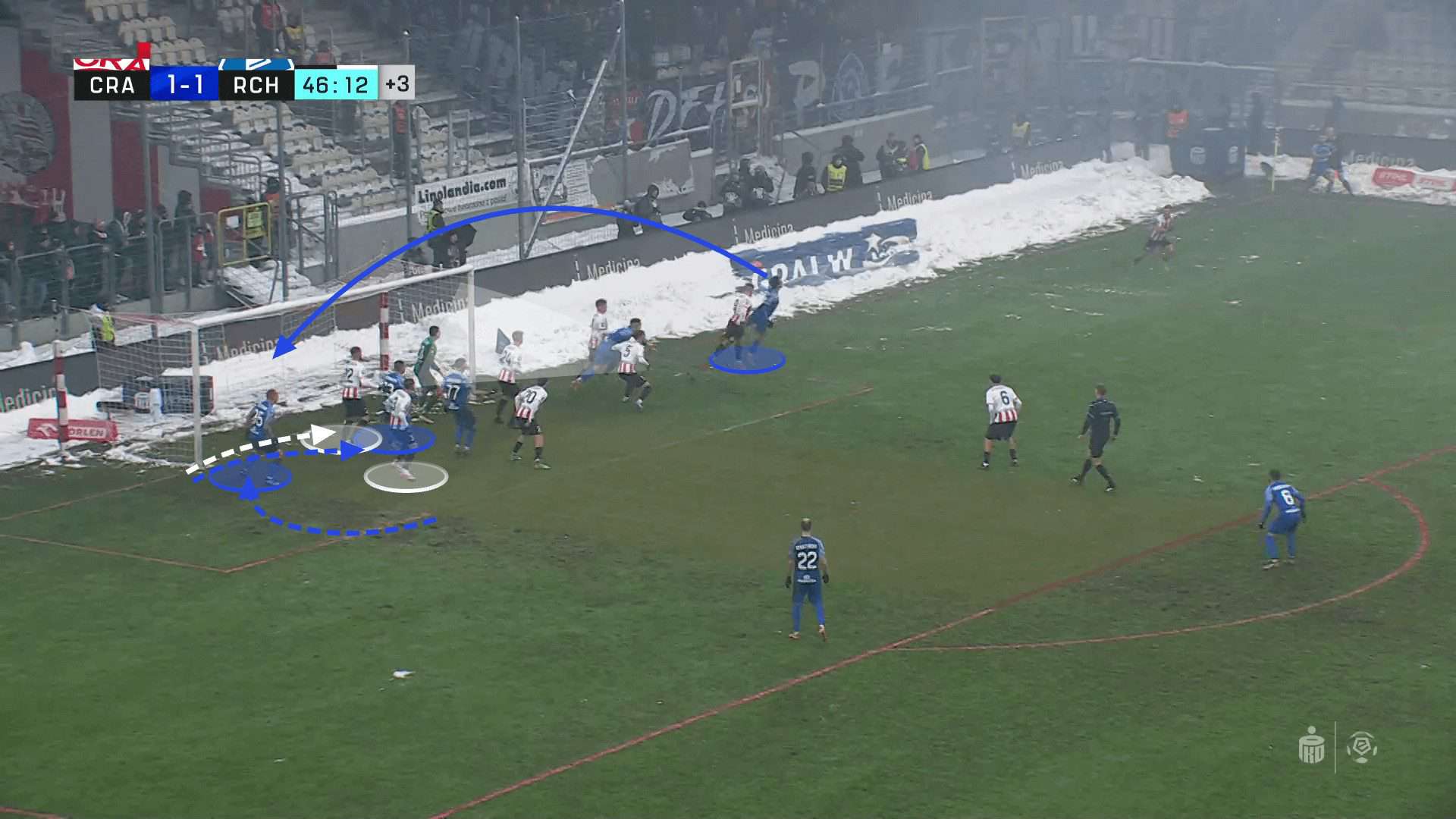
The intention of the near-side attacker should always be to header the ball into the part of the goal that is most open. Usually, goalkeepers come over to cover the goal’s near side, making the flick to the back post the most attractive option. While this has not been successful yet, Ruch Chorzów have the possibility to attack the near post more often. They utilise one player whose role is to block the goalkeeper and prevent them from moving from their spot. This is a flexible role, as the blocker can pivot around the goalkeeper to open up different parts of the goal. If Ruch Chorzów can make their routine even clearer for each attacker, they have a lot of untapped potential to make the most of.
In the image below, we can see the goalie cut off from moving towards the near post, which means that the option to head the ball into the near post is available. Every corner can be slightly varied by changing the position of the blocker, which opens up different parts of the goal. Thus, different routines should be used to penetrate those open spaces, which they have almost exclusively targeted at the back post.
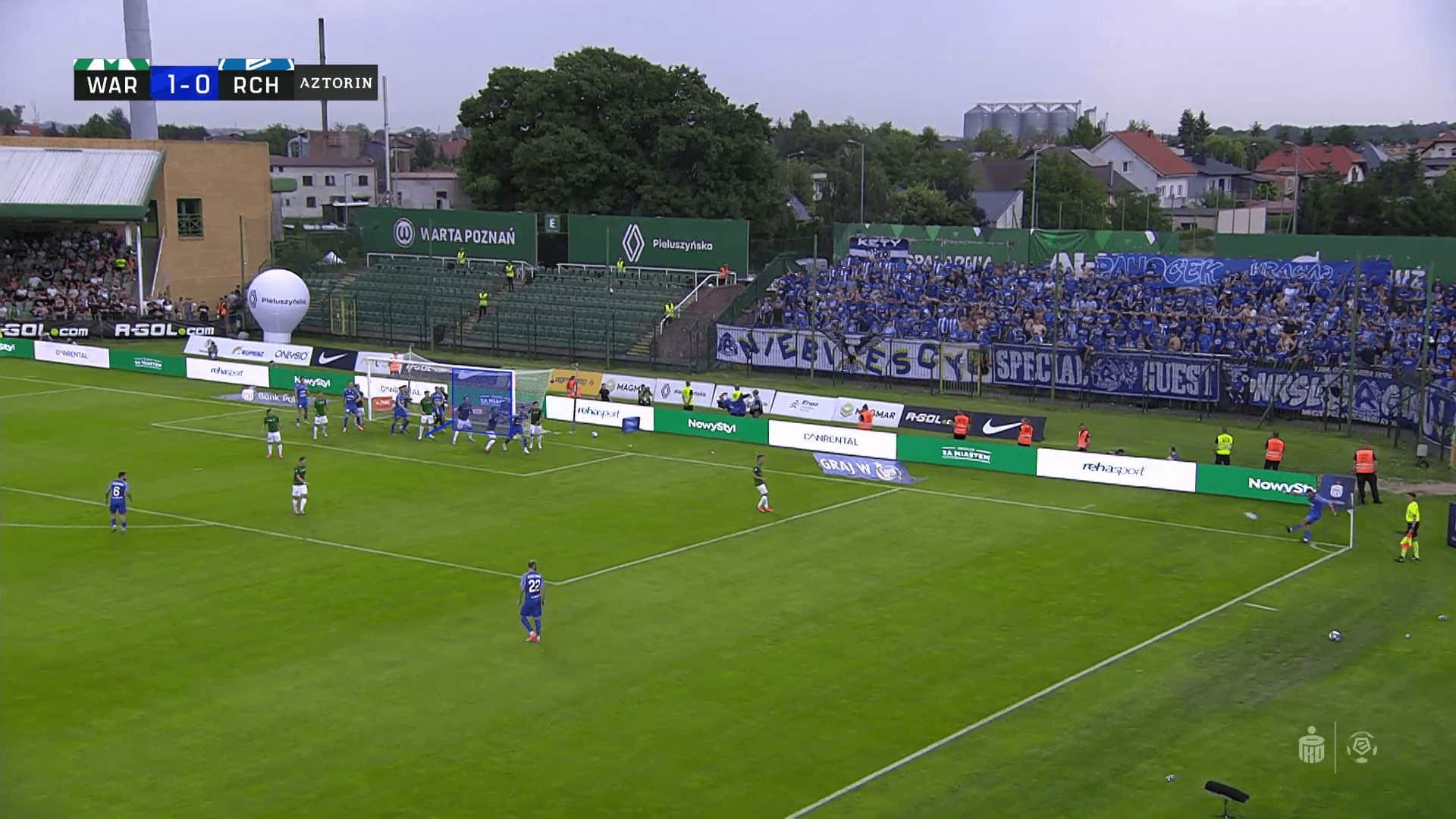
As we can see in the image below, a slightly different position of the block on the goalkeeper provides Ruch Chorzów with easy access into the six-yard box centrally, where a ball two or three yards away from the goal is open to attack. However, due to the lack of clarity and preparedness in knowing which area the goalkeeper is being blocked off from in that particular attack, no one is ready to attack the area which the goalkeeper is the most vulnerable to conceding a goal from.
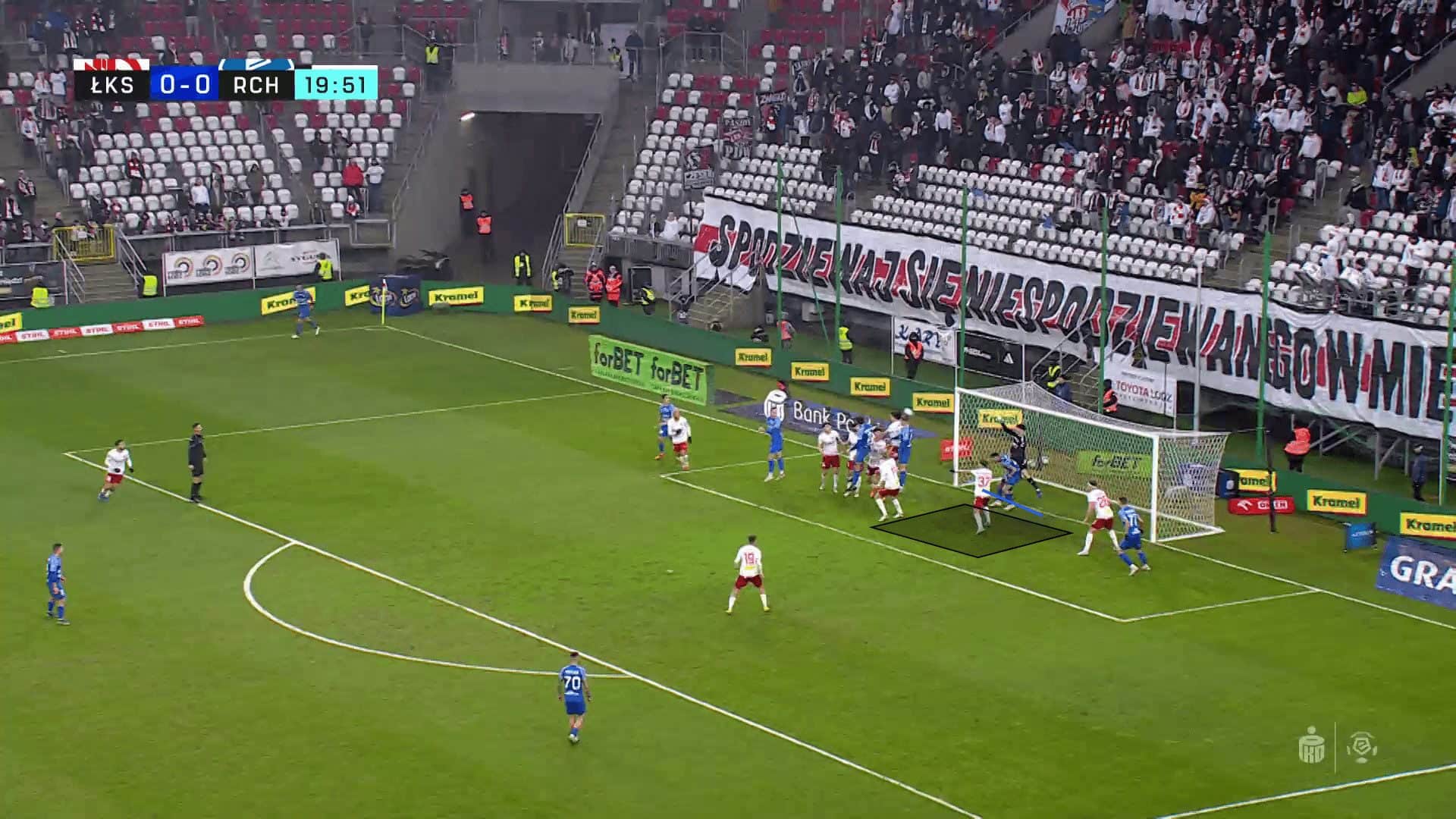
Benefits During the Second Phase
One of the most significant benefits a routine of crowding the box provides is the heavily concentrated presence of blue shirts in and around the six-yard box. Having so many players in such a small area massively increases the potential for Ruch Chorzów to sustain pressure by being more likely to react to loose balls or rebounds that fall inside the six-yard box. As we can see in the image below, players are scattered across the width of the six-yard box. This means that any loose ball falling anywhere inside the six-yard box will have a blue shirt waiting to attack it. In the particular example below, the furthest player to the right of the five highlighted can be seen lunging at the ball, blocking a clearance by the defender. The ball bounces up, and with four other blue shirts close by, they are able to win the second ball and attempt a shot on goal rather than having to defend a counterattack.

Furthermore, having so many bodies inside the six-yard box makes it highly challenging for the goalkeeper to step off his line and claim the ball. With so many obstacles in the path of the goalkeeper, they must first focus on being able to step out from their line to the ball in the instances it is possible to do so, and after they have stepped out, they must battle with numerous blue shirts to get their hands on the ball. The approach to the cross often leaves goalkeepers off balance, which often results in goalkeepers failing to make solid contact with the ball. This means the ball is rarely ever cleared away from the box but only falls towards the edge, where there are blue shirts ready and waiting to take a shot on goal.
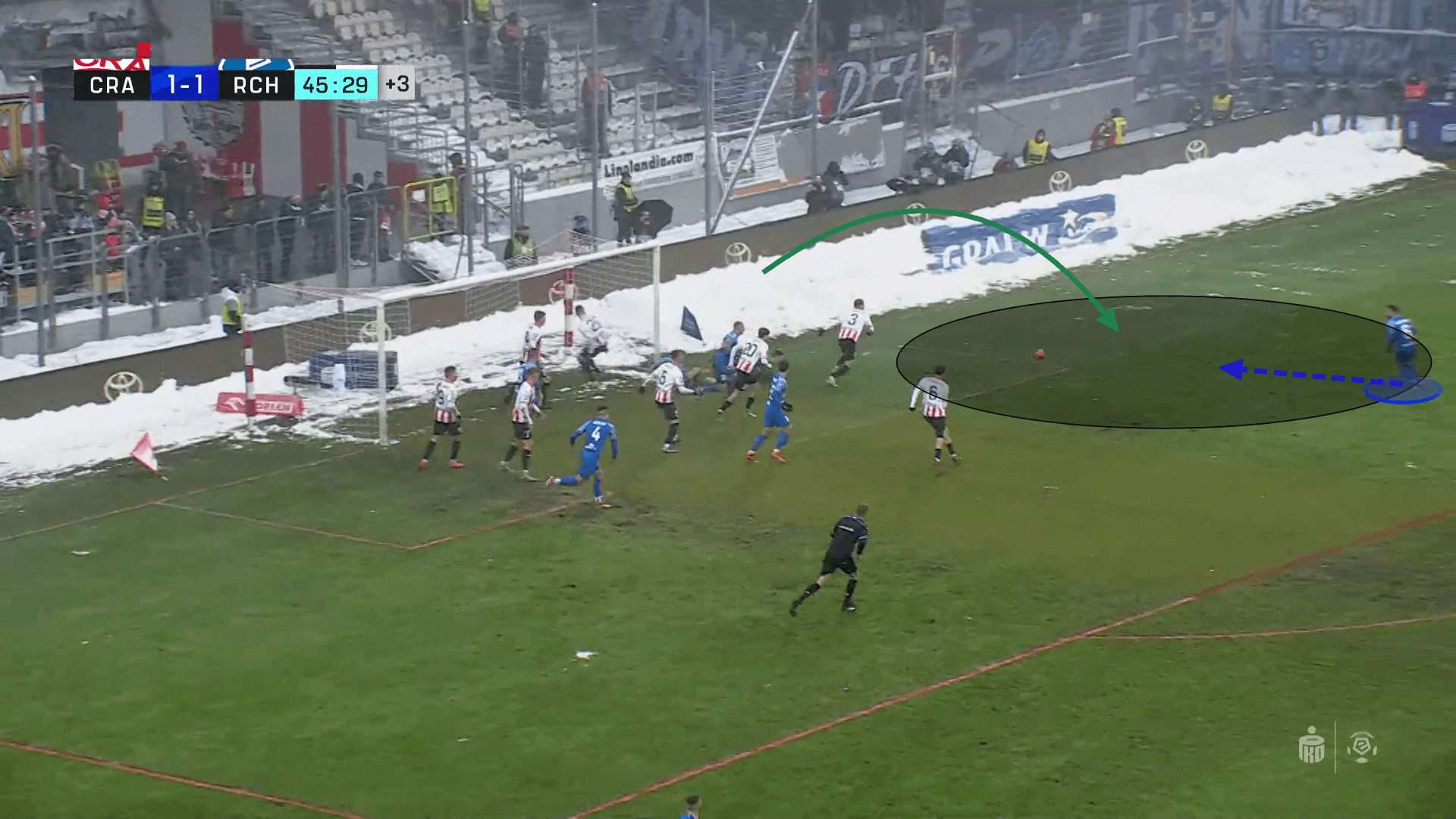
Flaws of Ruch Chorzów’s Interpretation
While Ruch Chorzów have been successful from corners, there are some steps they could take to increase their efficiency of corner-taking.
Firstly, the image below should clearly show the cause for concern during attacking corners. While Ruch Chorzów control and dominate loose balls that fall inside the six-yard box, the rest of the penalty area is neglected. There is a massive space between Ruch’s attacking unit and the rest-defence, situated on the edge of the box. Any ball that is headed slightly away from the goal falls into the white area below and instantly leads to a turnover, giving the defending team an easy way of getting rid of pressure.
The key to sustaining pressure is close distances between all units, where the failure to do so here means that players in the white area have plenty of time to control the ball, look up and make their decision, whether that is a pass, dribble, or clearance. Corner kicks provide teams with the opportunity to sustain pressure and relentlessly cross the ball into the penalty area, one after another, where attacking teams can prepare their positions to be ready to pounce on any loose ball and attack the box continuously.
Ruch Chorzów have actually scored through this method this season. Still, the inability to control the entire penalty area means that they have missed out on numerous opportunities to do so again.
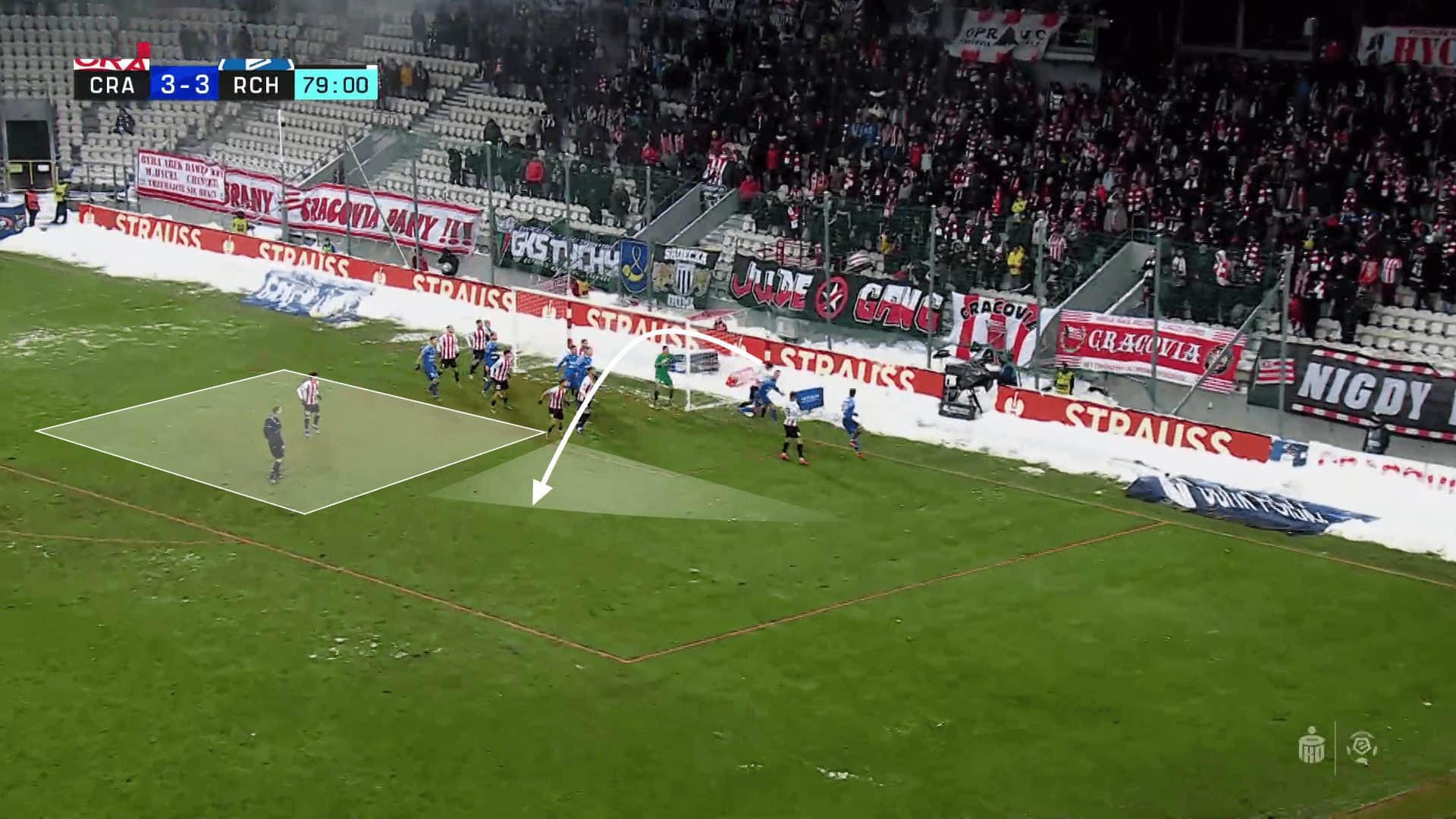
One of the biggest issues of this routine is the lack of support for the near-side attacker. This routine is dependent on the near-side attacker, but that also means that the delivery to that player must be accurate consistently, which is tough. Ruch Chorzów should increase their chances of the ball reaching the back post area by increasing the number of attackers attempting to make that first flick-on.
I’ve released articles in the past on the likes of Genoa this season or Tottenham when Gianni Vio was in charge of set-pieces, but there is a common solution to this problem. Suppose additional attackers make movements into the space behind the attacker in front, in a sort of chain reaction. In that case, they can increase the probability of a blue shirt making the first contact.
The image below shows that Ruch Chorzów control the spaces on the near side of the box (through arrivals from blind spots), the centre of the six-yard box (through preventing the goalkeeper from claiming the ball) and the back post (through rotations). However, they fail to have a presence in the red area. If they could add an extra two attackers, attacking the space behind one another, they would be able to increase the chance of making that crucial flick-on for a certain tap-in at the back post.
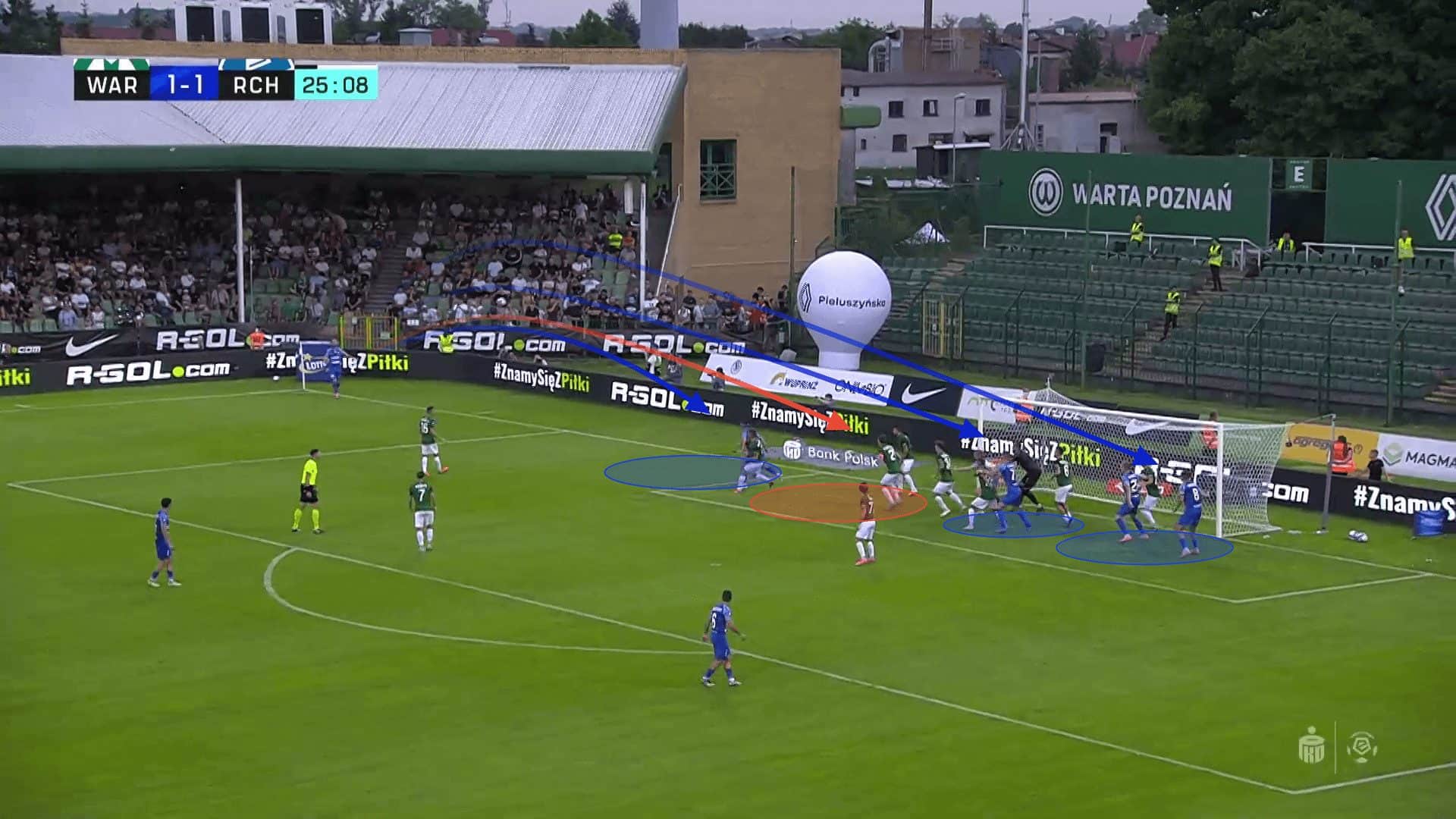
Summary
This set-piece analysis has detailed both the benefits and flaws of Ruch Chorzów’s corner kick design in their fight for top-flight survival. Packing the six-yard box has proven to be an effective chance-creation method, especially as it leads to so many chances created from loose balls in the second, but the failure to control the zones surrounding the penalty area should be addressed. Furthermore, some steps can be taken to both provide the near-side attackers with more space and time and increase the probability of making the first contact.
Nevertheless, this is one of the more successful corner kick routines, averaging a goal from every 14 deliveries around Europe this season, and Ruch Chorzów’s new manager can turn to set-pieces as one of the ways they can retain their place in the Ekstraklasa, with a proven method of creating chances.






Comments